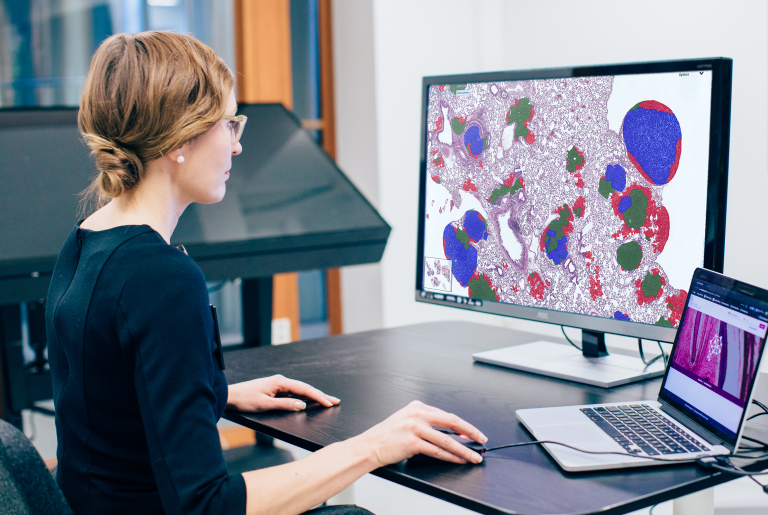Diagnosing cancer with a dose of AI
← Back to press releases
Aiforia is the fourth EIC Champion covered in our blog series of: “What does it take to become an EIC Accelerator Champion”.
So how did they do when benchmarked against our 6 key things to consider when raising funds?
Aiforia met all the six criteria that we have found that the EIC Accelerator seeks and were awarded €2 million in non-dilutive grant funding to finalize & scale-up their solution to automate time-consuming and manual medical imaging tasks in cancer diagnostics and pathology.
In the world of healthcare, where decisions can be a question of life and death, Aiforia enables healthcare professionals to make better informed diagnostic and treatment decisions for patients faster, ensuring higher quality care and more personalized treatment!
Why Aiforia does what they do?
You’d think that in the 21st century where robotic surgeries have become the norm that similar developments would have taken place in all areas of medicine… But, think again!
Pathology connects science and medicine. Despite its pivotal role, reviewing tissue samples, in the form of counting cells, measuring tumours and looking for patterns, has been manual work done by pathologists. Thus, this is simply too time-consuming and prone to error while patients wait for results and the right course of action.
As researchers at the Institute for Molecular Medicine Finland (FIMM), two of the co-founders of Aiforia, Dr. Johan Lundin and Dr. Mikael Lundin witnessed the glooming bottlenecks in pathology first hand.
Pathologists, severely outnumbered by the increasing number of tissue samples from cancer and other diseases, still spent weeks in laboratories to manually analyse samples for signs of disease.
Couple this rising rate with the fact that less doctors are specialising in the field… we might have waved the white flag to signal a lost battle before it even started...
So… Johan and Mikael decided to unleash the data hidden in tissues and help pathologists make faster and more consistent decisions with the power of AI.
Thus, enabling personalised care for better and faster treatments. And so, AI for Image Analysis… or how we refer to it… “Aiforia” was formed!
How Aiforia solves existing problems & disrupts the market?
There’s more than meets the human eye…
Aiforia made it possible to automate medical image analysis that has traditionally proved to be nearly impossible for the human eye to handle.
Aiforia, now helps to reveal all the information and data previously hidden in images.
Slow, manual, and bias-prone analysis tasks can now be automated to visualize and create quantitative and highly accurate data.
What is the breakthrough innovation behind Aiforia?
Aiforia is designed to take advantage of the versatility of Deep Learning neural networks. So, for the first time, very complex image analysis tasks can be fully automated across pathology and other medical fields.
The system can be taught to detect any feature a human expert can recognize. Even more so, a machine is finally able to mimic humans in understanding the broader context in tissue.
This significantly enhances the quality of for example cancer diagnostics and improves treatment outcomes.
Seems like a much-needed breakthrough to me… especially when there is a rising rate of cases and a declining rate of specialised doctors!
Did Aiforia really try to raise funds prior to EIC funding?
Oh yes, they did!
When Aiforia was founded in 2013, the R&D efforts were supported through the government supported loans and grants, as well as by angel investors. In 2017they went on to raise €5 million of private capital to develop the first version of Aiforia.
But during their fundraising efforts, they also got a lot of NO-s for developing their disruptive technology…
Why?
Because machine learning systems are complex. Simply, it is extremely difficult for general VCs to assess which highly technical AI-powered solution is a good investment and which is not.
Did Aiforia have a clear value proposal?
Their value proposal was extremely clear and tailored to target the critical needs of the medical community.
It is the first commercial software solution proven to improve the speed, efficiency and consistency of medical image analysis in areas such as cancer diagnostics, in an agile and adjustable manner.
The solution supports pathologist’s analysis with computer-generated insights. Ultimately allowing patients to receive better and faster treatment.
No method available can provide as deep insights into the tissue samples as Aiforia does.
Who could say no to that?
How is Aiforia’s high risk-reward business scalable?
The cloud platform enables Aiforia to generate an easily scalable and disruptive business model with low cost to the customer.
Although Aiforia was initially focused on diagnosing various types of cancer, the novel algorithms behind the technology can be applied to a wide range of diseases such as Parkinson’s, Alzheimer’s, liver inflammation, malaria infection, and more for use in medical research, preclinical investigation, and clinical diagnostics.
Putting it all together!
Ultimately, Aiforia met all the criteria that EIC Accelerator (then SME Instrument) seeks and were awarded non-dilutive grant funding.
This is why they became a champion! They were simply a perfect match!
When reading about Aiforia diagnosing cancer with a dose of AI, did you see why they were a Champion before they officially became one?
Did you notice any similarities between how YOU operate and innovate?
If yes, then reach out to us!
← Back to press releases



_block.jpg)